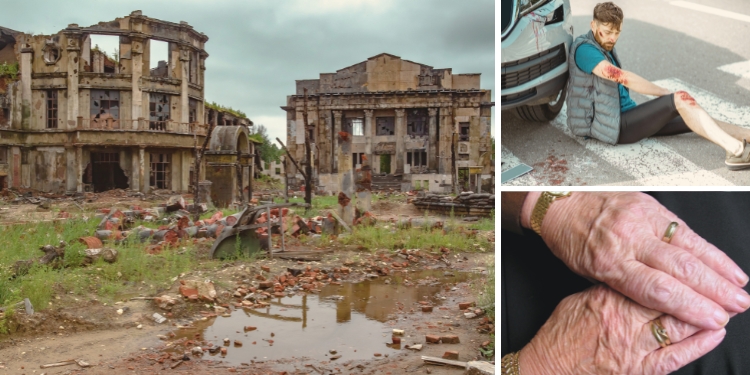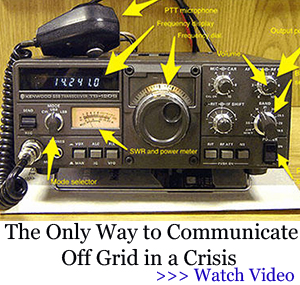No prepper expects getting though a major crisis to be easy. When the SHTF there’s going to be a lot of hard work. There’s going to be discomfort. There’s going to be danger. Unexpected problems will pop up and need to be dealt with. This is all stuff preppers think about and (the clue’s in the name) prepare for. But have you considered what to do if you find yourself forced to make a choice that seems impossible – a decision where there’s no good option, just a series of bad ones?
Unfortunately, there are times when tough choices just have to be made – and, like most things, they’ll be easier if you’ve thought about them in advance. Let’s take a look at some of the worst-case prepping scenarios where you have several courses to choose from, and none of them are looking good.
Should I Stay Or Should I Go?
In an emergency, one of the first decisions you’ll have to make is whether to bug out to a safer location, or “bug in” right where you are. This can be a hard choice to make. Most of us already lean one way or the other. Either we already have a Bug Out Location picked, prepared and stocked with supplies, or we’ve made sure our home is still a viable location in a crisis. The problem is, when disaster strikes it might not come in the form we’d expected. What if we’d planned to bug in, but now there’s a wildfire raging and the wind’s blowing it our way? Or we’d planned to bug out, but there’s a big mushroom cloud rising over where our BOL was?
You need to be ready to change plans at short notice. That can be hard when you have a lot of time and money invested in one option, but if that option is obviously not going to work the tough decision has to be made.
If You Plan to Bug In, Stop Doing This Immediately!
The link above tells you about 3 huge mistakes people who bug in make right now. It is also where you will learn more about the Navy SEAL’s Bug-In Guide, the ONLY guide we always have to recommend when we talk about how to stay safe in the comfort of your own house.
Why is that?
It teaches you literally EVERYTHING you need to know when you bug-in, from how much food you ACTUALLY need to stockpile to how to set up traps to increase perimeter protection. And the guide is also written by an actual Navy SEAL instructor who has first-hand combat experience in both bugging out and bugging in situations. Just do not ask him what his opinion is on bugging out.
Learn more about what is included in the guide here!
Medical Triage
Being able to deal with medical issues is a key part of prepping; when the SHTF it’s unlikely the ER will be an option, so most of us collect the skills and supplies we need to do as much as possible ourselves. But what if you find yourself in a mass casualty situation? Even hospitals can get overwhelmed, and as a prepper with a first aid kit and maybe a couple of willing but unskilled helpers you have a lot less resources than a hospital.
Related: 9 Unusual Things You’ll Find Inside an Army Medic’s First Aid Kit
You need to decide which patients to spend your time and medical supplies on. That’s a very hard decision to make – because while you’re treating one casualty, you’re not treating the others. However, you can’t be everywhere at once. Keeping the maximum number of people alive and healthy means prioritizing your efforts. To decide who to treat first, you need to quickly examine every casualty, then divide them into four groups:
- Immediate – These are the people with life threatening injuries that you can treat. Anyone who’s not breathing, has a blocked airway or severe bleeding falls into this category. As the name suggests, they need to be treated immediately. If you have more than one Immediate casualty, prioritize them with ABC, where A is Airway, B is Breathing and C is Circulation (bleeding).
- Urgent – Anyone with significant bleeding, major burns or broken bones needs treated as soon as possible, but they don’t need immediate attention to save their lives. Stabilize the Immediate casualties before moving on to Urgent ones.
- Routine – Minor injuries that need some treatment can be left until last. Small cuts or burns, bruises and similar superficial wounds are in this group. Don’t leave them waiting longer than you need to, but they won’t come to much harm if they need to wait a few hours or even days while you deal with the serious cases.
- Untreatable – Unfortunately, some people will have life-threatening injuries that are beyond your ability to treat. It’s hard, but necessary, to stop treatment – especially if it’s someone you’re close to. However, if you’re spending time on someone you can’t save while Immediate patients wait, people will die who could have survived. Help those you can save. When time and resources allow, you can come back to untreatable patients and do what you can to make them comfortable.
You Will Let People Die
Triage is used in a medical context, because sometimes you can’t treat all the casualties. The same principle applies to other scenarios, though. What if refugees are moving past your home or BOL? What if parents are knocking on your door, asking for food for their hungry kids? It’s hard to turn away a starving child, but it’s depressingly easy to wipe out your own food supply in exchange for keeping a lot of unprepared people alive one day longer. Eventually, even if you do not do it in the beginning, you will have to say NO and let people die.
You Will Abandon People You Care About
Even within your own group, there might come a time when you have to make ugly choices. What if one member of the group is slowing you down, and putting you all in danger? Do you leave them behind to protect the majority, or try to keep them with you and risk everyone’s lives? Choosing to abandon someone – perhaps a close relative – is a terrifying decision to think about, but it could become necessary.
You Will Run If You Want To Survive
In a SHTF scenario, there’s a high chance of conflict with other people. Your stockpiles, and even your knowledge, are resources other survivors will want to get their hands on. If you want to keep the preps you’ve built up, you might have to fight for them. In the worst case scenario, it might be necessary to kill for them.
Where you draw the line on the use of lethal force is a personal decision. Most of us would use a gun to defend our own life and the use of our loved ones. Few of us, I’d like to think, would open fire to save one can of baked beans. The decision you make will depend on the value of what’s threatened and the possible consequences of using force. Are you in an armed standoff where you might be able to disengage and withdraw without a fight? Is society gone for good, or is there a chance law enforcement will be back in a couple of weeks?
How Much Will You Risk?
There are times you could be faced with a choice between taking a moderate risk right now to avoid a less immediate but more serious one. What if you’re out of food and starting to suffer from malnutrition, and you find a tree loaded with unfamiliar fruit. It’s food, but is it safe? You can do a taste test like you learn from the Wilderness Survival Guide, and if it doesn’t taste of almonds or cause a burning sensation there’s a good chance it’s edible – but it might not be. Will you risk it, or face the danger of starvation? Thirst will kill you much quicker than hunger, so what if you’ve been out of water for days then find a pool that might be contaminated? Will you run that risk? Just remember there’s one hard rule when it comes to water: Drinking seawater is never going to be the best option. If you’re 99% certain to dehydrate, that’s still better odds than drinking seawater.
Any time you’re preparing or making plans, try to consider worst-case scenarios that could lead to tough choices. Then think about the factors that will play on the decision you have to make. That’s especially important if you’re making plans for a group, because that’s when you’re most likely to face the difficult decisions. It can be unpleasant to think about some of these scenarios, but it’s definitely worthwhile. If you do some groundwork now, you’ll be ready if the time ever comes. When the worst happens, you might not immediately know what to do– but you will be prepared to make a decision.
You may also like:
How to Build an Underground Bunker for Only $400 (Video)
















A more complete assessment is ABCDE
Airway
Breathing
Circulation
Disability
Exposure
https://geekymedics.com/abcde-approach/
Just like the medical industry and FPI , LSI , other agencys
Always
but the choices you make today affect where, what , why things happen tommorrow
Lack of Planning creates Kos
God is Structured, orderly and Disciplined
everything will always have a cause and effect later and not what you expected
and those around you are affected by your choices
Be Wise, Be alert , Think before you act so you will make proper decisions
Too Much is Too Much
And there is so much deception in the social arena , you cannot trust the News, propaganda Networks of lies and deception .
Research , research , research
Wow, what a doom and gloom scenario! C’mon Man! From what I have seen even in a complete war zone medical personnel stay until the end. (just watch the TV) Medical people train for this ,this is personal to them and most of them will give their life to help save one person! If things ever get that bad…Jesus take the wheel!
Stay safe and God Bless…
Not a prepper? Why are you here? We are not medical personnel so not having the skills that they have, we have to make more choices than they have to make. This isn’t doom and gloom. It’s reality and could be our reality one day. You have to be ready. You can’t just turn your back and pretend it doesn’t exist.
I’m trying to figure out how to “potty” my large German Shepards- normally yard dogs-when a nuke hits & they must stay inside with me for that initial 5 days. Any ideas on that?
1) Lg. pc. Astro-turf (fake grass) / over equally large pc. of cheap carpet (to obsorb) / over lg sheet of plastic (to contain)
OR
2) A huge metal pan that the mechanics use under cars in garages & Pour a few bags of kitty litter in.
Put a dog toy/bone in the center of each to attracked K9.
OR
3) Get a cat/ bird/ teacup poodle/ chihuahua next time. In my family, these ALL easily survived thru Hurricanes & Earthquakes. AND when the stores were closed for 3 weeks….. we did not run out of food / treats / toys / sm.beds / water bottles (which all fit in an aprx. 3½”×2’×2″ plastic EMERGENCY box [water resistant & floats].)
~from which I recycle (& use) all consumables yearly.
Are you prepared to look at your Shepard as ’emergency rations’?
If not…you should think about it.
I’m trying to figure out how to “potty” my large German Shepards- normally yard dogs-when a nuke hits & they must stay inside with me for that initial 5 days. Any ideas on that?
Teach them to use potty pads placed on a hard floor. It’s possible they may have used them as puppies before you got them.
Walk them anyway….so they can potty in your neighborhood….sorry… i was bitten by a dog in the face when i was a child…i was just giving it a hug….what was even more tragic the owners put it to sleep……
You think our soldiers haven’t had to make these kind of decisions everyday. Did you know that there are black cards that they place on victims in mass causalities in every hospital in this country that indicate that this victim is not going to make so move on to one you can save. They are comfort measures only if you have time and resources. That is reality. Go ask. Volunteer for the next mass casualty exercise in your area. It’s a horrible reality. But by putting this information here it’s causing folks to think about, it’s causing folks to discuss it, to prepare mentally for the possibility. It’s called preparedness.
Howdy from an undisclosed location high in the desert swamp,
I coordinated a mass casualty exercise involving police, fire, Coast Guard and State agencies. Scenario was a Plane crash landing in a neighborhood. The placement of DNR cards is real. Treat what you can and move on. People having parts to play were everything from catatonic to belligerent hysterical. Wow was that enlightening. Another one was in Hawaii. 757 brought in an unknown flu. Again multiple agencies and wow. I have sat back and written scenarios and the town I live near does not want to do this. So, I run through the previous to drills and imagine no help or sporadic help with no one in charge. Wow again. These articles may seem exaggerated but experience says they are not. If anything they are underplayed. It’s all in the fan?? You’re on your own or your group is on their own. Look as recent as NOLA hurricane Katrina. If anyone actually knows the true number of dead and the cause? It’s not being published. Clean water will be the catalyst. Everything else after that is use your imagination. Unless my house is destroyed Im bugging in. My physical condition is my factor. Anything else will be a decision at that time.
Remember to have your soul prepared.
Remember the Alamo. They killed everyone
Remember North Carolina. The government is no help
Chaplain Dan, I always seem to learn something from your posts. Thank you.
A friend of mine had similar exercises to consider for a time. The threat did not occur, but it certainly got her to thinking, and she passed along some of what she learned to me.
It’s good to revisit these scenarios from time to time because your life situation may have changed from when you initially planned on what you would do. Bugging out and carrying a pack 20 miles a day might work when you’re in peak physical condition, but if that was over 25 years ago when you were fretting about Y2K, you might find that today it would make more sense to stay put, lose the pack altogether in favor of caches, or update how many miles you could truly cover.
Lets start at the beginning, stay or go ?
if you choose go, your prepping for a 6 day event, and your going where your credit card takes you, you will need enough gear to hike 25 miles IF the road is out, thats IT !
If you choose STAY Then you HAVE been prepping for SHTF, your NOT in an Urban setting and you have answered the go question years ago.
SO are you prepping for S. Hits The FAN – Stay safe for the next three years
or prepping for Snow Hindered The Family – stay in apartment for 3 days
Only if your life or freedom is in imminent threat should you bug out.
Take care of yourself first THEN aid others in medical emergencies.
If you give out food for any reason, expect the stray cat scenario where you feed on, MANY others come for the food.
And if you stop, expect serious violence against you.
People, in particular women and children run their mouths.
Loose lips sink ships as it were.
Would Fergus Mason abandon his wife or children if they were slowing him and the group down? I doubt it. Big tough talk there, but I doubt it.
I want to order the book, The Navy Seals’ Bug-In Guide. Where do I send my check for $37, and make it payable to whom? Or would you rather have a credit card charge?
I’m 87.5 years old, but I expect to make it to 120. And I am alone! I would choose to “bug-in” rather than bug-out, and have already begun stockpiling food not requiring refrigeration.
Hello, Just click on the link above in the article or here: https://hop.clickbank.net/?affiliate=lostways&vendor=buginguide&tid=A02CruceImpossibleSHTFBIG3
Down on the list you see Add to Cart. There you can pay with your credit card. Please remember that the physical copy also has shipping and handling. All details are there after you add to cart.
You Will Abandon People You Care About
Let me tell a story from a few years ago, about Sept 1969. I was going in front of an Army oral board for a chance at another stripe. A clearly new in country 2nd lieutenant was quizzing me on this very subject. I told him I would not leave a team member behind. He continued coming at me with slightly different variations and reminding me its mission first, welfare of the men second. I said sir I studied from the same book you did but I have been in the field long enough and know my own feelings well enough that I am telling you I won’t do it. I won’t leave a man behind. He tried one more time and the Major cut him off. I got my stripe and he got the ass chewing.
The problem is most people are not in the army. In the army we have the mantra of leave no man behind. Regular people do not. At the end of the day it is a choice and most people will choose to leave those they care behind in order to survive.
Like my X-wife…..